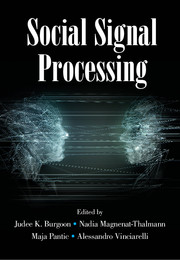Book contents
- Frontmatter
- Contents
- Contributors
- 1 Introduction: Social Signal Processing
- Part I Conceptual Models of Social Signals
- Part II Machine Analysis of Social Signals
- 11 Facial Actions as Social Signals
- 12 Automatic Analysis of Bodily Social Signals
- 13 Computational Approaches for Personality Prediction
- 14 Automatic Analysis of Aesthetics: Human Beauty, Attractiveness, and Likability
- 15 Interpersonal Synchrony: From Social Perception to Social Interaction
- 16 Automatic Analysis of Social Emotions
- 17 Social Signal Processing for Automatic Role Recognition
- 18 Machine Learning Methods for Social Signal Processing
- Part III Machine Synthesis of Social Signals
- Part IV Applications of Social Signal Processing
- References
15 - Interpersonal Synchrony: From Social Perception to Social Interaction
from Part II - Machine Analysis of Social Signals
Published online by Cambridge University Press: 13 July 2017
- Frontmatter
- Contents
- Contributors
- 1 Introduction: Social Signal Processing
- Part I Conceptual Models of Social Signals
- Part II Machine Analysis of Social Signals
- 11 Facial Actions as Social Signals
- 12 Automatic Analysis of Bodily Social Signals
- 13 Computational Approaches for Personality Prediction
- 14 Automatic Analysis of Aesthetics: Human Beauty, Attractiveness, and Likability
- 15 Interpersonal Synchrony: From Social Perception to Social Interaction
- 16 Automatic Analysis of Social Emotions
- 17 Social Signal Processing for Automatic Role Recognition
- 18 Machine Learning Methods for Social Signal Processing
- Part III Machine Synthesis of Social Signals
- Part IV Applications of Social Signal Processing
- References
Summary
Introduction
Synchrony refers to individuals’ temporal coordination during social interactions (Cappella, 2005). The analysis of this phenomenon is complex, requiring the perception and integration of multimodal communicative signals. The evaluation of synchrony has received multidisciplinary attention because of its role in early development (Feldman, 2003), language learning (Goldstein, King, & West, 2003), and social connection (Harrist & Waugh, 2002). Initially, instances of synchrony were directly perceived in the data by trained observers. Several methods have been proposed to evaluate interactional synchrony, ranging from behavior microanalysis (Cappella, 1997) to global perception of synchrony (Bernieri, Reznick, & Rosenthal, 1988). Behavioral synchrony has now captured the interest of researchers in such fields as social signal processing, robotics, and machine learning (Prepin & Pelachaud, 2011; Kozima, Michalowski, & Nakagawa, 2009).
In this chapter, we focus especially on description and definition of synchrony for the development of computational models. The chapter begins with a review of evidences of interpersonal synchrony from different research domains (psychology, clinics, neuroscience and biology). Then, we introduce a working definition of interpersonal synchrony (see Proposed Definition). The chapter surveys evaluation models and methods from the literature of psychology (see Non-computational Methods of Synchrony Assessment) and social signal processing (see Fully Automatic Measures of Synchrony). Finally, the chapter discusses a number of challenges that need to be addressed (see Conclusions and Main Challenges).
Non-verbal Evidence of Interpersonal Synchrony
Among social signals, synchrony and coordination have been considered lately (Ramseyer & Tschacher, 2010; Delaherche et al., 2012). Condon and Ogston (1967) initially proposed a microanalysis of human behavior (body motion and speech intonation) and evidenced the existence of interactional synchrony, the coordination between listener's and speaker's body movements, or between the listener's body movement and the speaker's pitch and stress variations. Bernieri et al. (1988) define coordination as the “degree to which the behaviors in an interaction are non-random, patterned or synchronized in both form and timing”. (Kendon, 1970) raises fundamental questions about the condition of interactional synchrony arousal and its function in interaction. When he synchronizes with the speaker, the listener demonstrates his ability to anticipate what the speaker is going to say. In this way, he gives feedback to the speaker and smoothens the running of the encounter.
- Type
- Chapter
- Information
- Social Signal Processing , pp. 202 - 212Publisher: Cambridge University PressPrint publication year: 2017
References
- 10
- Cited by

